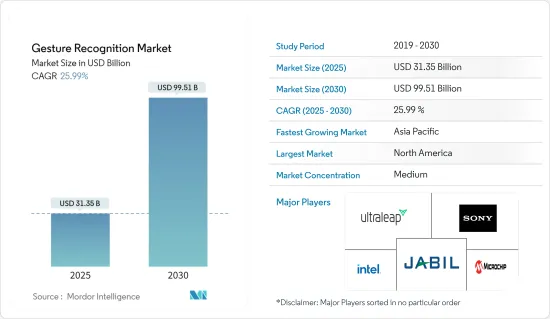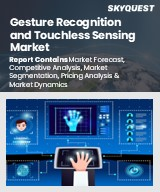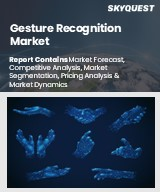
|
시장보고서
상품코드
1637920
세계의 제스처 인식 시장 : 점유율 분석, 산업 동향 및 통계, 성장 예측(2025-2030년)Gesture Recognition - Market Share Analysis, Industry Trends & Statistics, Growth Forecasts (2025 - 2030) |
||||||
제스처 인식 시장 규모는 2025년 313억 5,000만 달러, 2030년 995억 1,000만 달러로 추정되며 예측 기간 중(2025-2030년) CAGR은 25.99%에 달할 것으로 예측됩니다.

주요 하이라이트
- 인공지능(AI)의 개발로 제스처 인식 기반 장치가 탄생했습니다. 게다가, 제스처 인식 기술 분야의 최근 기술 진보는 최종 사용자 산업에서 채용 증가와 함께 향후 몇 년간 시장을 견인할 것으로 분석되고 있습니다.
- 제스처 인식 기술은 텔레비전 채널과 라디오 방송국의 전환 등 다양한 산업에서 제스처 대응 전자 디바이스의 수용이 진행되고 있기 때문에 인간과 디바이스의 상호작용을 위해 점점 구현되고 있습니다. 제스처 인식의 이용은 다양한 분야에서 증가하고 있습니다.
- 이 분야의 최근 동향 중 하나는 핸드 제스처 인식을 사용하는 인간과 기계의 상호 작용입니다. 또한 컴퓨터 용도을 제어하기 위해 핸드 제스처 인식을 사용하는 것도 개발되었습니다.
- 지속적인 기술 개척에 따라 조사 대상 시장의 기업은 새롭고 혁신적인 기능을 통합한 제품을 제조하고 있습니다. Omron Corporation는 카메라로 촬영한 이미지를 참조하여 사람의 손과 손가락의 위치, 모양, 움직임을 동시에 인식하는 제스처 인식 기술을 개발했습니다.
- 또한, 제스처 인식 기술은 다양한 전자 제품을 다룰 때 사용자의 편의성을 높이기 위해 소비자와 OEM 제조업체들 사이에서 큰 관심을 끌고 있습니다. 전 세계 제조업체들은 다양한 가전제품에 제스처 인식 기능을 추가하는 기술 혁신에 주력하고 있으며, 이로써 안전성, 신뢰성 및 편리성이 향상됩니다. 또한, 터치리스 제스처 인식에 대한 수요는 뛰어난 사용자 경험, 사용 편의성, 다양한 분야에서 디지털화의 발전에 대한 수요 증가에 지배되고 있습니다.
- 제스처 인식 용도 시스템은 몇 가지 주요 하드웨어 및 소프트웨어 구성요소로 구성되며, 매력적인 사용자 경험을 제공하기 위해 이들 모두가 긴밀하게 통합되어야 합니다. 또한 특수 알고리즘이 처리된 데이터를 해석하고 움직임을 컴퓨터가 이해할 수 있는 실행 가능한 명령으로 변환합니다. 그런 다음 애플리케이션은 이러한 실행 가능한 명령을 자연스럽고 매력적이어야 하는 사용자 피드백과 통합합니다. 솔루션의 전반적인 복잡성 외에도 알고리즘과 용도는 처리, 스토리지 및 기타 리소스가 제한된 임베디드 시스템으로 구현되는 경우가 많습니다.
- 또한, 제스처 인식 생태계의 인공지능과 머신러닝과 같은 첨단 기술의 통합은 연구 시장을 더욱 확대하고 있습니다. AI와 ML 기술의 보급은 의료 전달, 스마트 네비게이션, 가전, 증강현실 게임, 가정 자동화, 라이브 비디오 스트리밍, 가상 쇼핑 등 다양한 기능을 강화하는 용도을 제공함으로써 제스처 인식의 패러다임 변화를 일으키고 있습니다.
제스처 인식 시장 동향
터치 기반 제스처 인식 분야가 큰 시장 점유율을 차지할 전망
- 터치 기반 제스처 인식은 가전제품에서 널리 사용되는 단일 터치 및 멀티 터치 스크린으로 구성됩니다. 하나의 터치 기반 기능은 스마트폰과 같은 많은 기기에서 사용할 수 있습니다. 예를 들어 원터치로 스마트폰 메뉴바에 액세스할 수 있습니다. 터치 기반 제스처 인식 분야는 앞서 언급한 기본 기능을 갖춘 노트북과 스마트폰의 보급률이 높기 때문에 시장의 대부분을 차지하고 있습니다.
- 게다가 스마트폰이나 노트북 등 터치 기반 제스처 인식을 채용·탑재하는 가전제품이 늘어나면서 이러한 가전제품의 보급은 시장 성장에 긍정적인 영향을 미칠 것으로 예상됩니다. 스마트폰은 저가격으로 터치 기반 제스처 인식 기능을 탑재한 스마트폰을 출시함으로써 기업이 아시아태평양, 특히 인도에 중점을 옮기고 있기 때문에 향후 수년간 지속적인 성장이 예상됩니다. 예를 들어 GSMA 데이터에 따르면 2022년 세계 스마트폰 보급률은 68%로 추정되고 있습니다.
- 멀티터치 기반 제스처 인식은 스마트폰 확대, 축소, 3손가락 스크린샷 등의 기능에 사용됩니다. Windows 10의 데스크톱 교체 및 메뉴 액세스 등의 기능은 노트북의 트랙패드에 탑재되어 있습니다. 현재 앞서 언급한 기본 기능을 갖춘 노트북과 스마트폰 시장 보급률이 높기 때문에 터치 기반 제스처 인식 분야가 조사 대상 시장을 독점하고 있습니다. 이 부문은 예측 기간 동안 변경되지 않을 것으로 예상됩니다.
- 현재, 스마트폰 제조업체는 더블 탭에 의한 슬립/슬립 해제 등, 터치 베이스의 제스처 인식 기능을 탑재한 스마트폰을 발매하고 있습니다. 또, 노트북 제조업체도 터치 베이스의 제스처 인식 기능을 탑재한 저가격 제품을 발매하고 있어, 이 기술의 이용 가능성을 높이고 있습니다.
- 또한, 터치 기반 제스처 인식 장치는 산업 용도에서 선호하고 사용됩니다. 이 업계의 작업 환경에서는 장갑이나 기름이 묻은 손으로 사용하는 등 가혹한 조건에서도 작동하는 견고한 장치가 필요합니다. 또한 특정 산업 기반 보안 및 표준 인증도 제품에 필요하며 이 업계에서 사용되는 제품을 구현하기 위한 프리미엄 솔루션입니다.
북미가 큰 점유율을 차지할 전망
- 북미는 제스처 인식 기술의 채택에서 시장의 선구자이며 주요 혁신자입니다. Jabil Inc., Leap Motion Inc., GestureTek Inc.와 같은 공급업체가 이 지역에 본사를 두고 있습니다. 이 지역에서는 전 세계 기타 지역에 비해 R&D 투자가 증가하고 있기 때문에 이 지역에서의 이 기술의 채택이 시장 성장을 더욱 끌어올릴 것으로 예상됩니다.
- 게다가, 고급 차량의 제스처 기반 사용자 인터페이스에 대한 수요가 증가함에 따라, 이 지역의 자동차 산업에서는 제스처 인식 수요가 증가하고 있습니다. 첨단 차량 기능에 대한 소비자의 선호도 증가와 OEM의 R&D에 대한 엄청난 투자는 제품의 보급을 촉진하는 것으로 보입니다.
- 수요면에서 미국은 구매 사이클의 감소와 주요 소비자층의 소비력 회복을 배경으로 가전기기의 유력 시장의 하나로 존재감을 유지할 것으로 예상됩니다. 예측 기간 동안 제스처 인식 기술이 가장 많이 사용되는 것은 가전제품일 것으로 예상됩니다. 휴대용 전자 제품과 무선 통신에 대한 수요 증가는 현지 시장을 견인할 것으로 예상됩니다. 미국은 세계 가전제품의 주요 소비국 중 하나입니다. 또한 미국은 기술 선진국으로도 알려져 있으며 여러 전자기기 제조업체의 목표가 되고 있습니다.
- 또한 이 지역은 소매 업계에서 중요한 지위를 차지하고 있습니다. 제스처인식기술의 채용도 소매 업계에서 성장할 것으로 예상되며, 이 지역 시장 성장을 더욱 뒷받침하고 있습니다. 오클라호마 주에 위치한 식료품점 체인 Reasor는 회사 로고와 메시지를 바닥에 투영하는 대화형 디스플레이를 설치했습니다. 고객은이 디스플레이를 걷고 간단한 제스처와 신체 움직임으로 상호 작용할 수 있습니다.
제스처 인식 산업 개요
제스처 인식 시장의 경쟁은 중간 정도이며 소수의 대기업이 큰 영향력을 발휘하고 있습니다. 현재 이러한 업계 선두는 압도적인 시장 점유율을 차지하고 있으며 해외 시장에서 도달범위를 확대하는 전략을 적극적으로 추진하고 있습니다. 이를 달성하기 위해, 그들은 시장에서의 존재감을 높이고 수익성을 높이기 위해 전략적 제휴를 맺고 있습니다.
최근의 동향에서는 2023년 6월, 핸드 트래킹과 공중 촉각 기술의 유명한 프로바이더인 Ultraleap사가 흥미로운 발표를 실시했습니다. Ultraleap은 BrightSign의 XC5 미디어 플레이어에서 회사의 TouchFree 솔루션을 지원한다고 발표했습니다. 이 통합은 디지털 사이니지에 새로운 차원의 참여와 인터랙티브성을 도입하여 시청자를 매료시키는 혁신적인 방법을 추구하는 기업과 조직에 다양한 잠재력을 제공합니다.
기타 혜택:
- 엑셀 형식 시장 예측(ME) 시트
- 3개월간의 애널리스트 서포트
목차
제1장 서론
- 조사의 전제조건과 시장 정의
- 조사 범위
제2장 조사 방법
제3장 주요 요약
제4장 시장 역학
- 시장 개요
- 업계의 매력도 - Porter's Five Forces 분석
- 공급기업의 협상력
- 구매자의 협상력
- 신규 진입업자의 위협
- 대체품의 위협
- 경쟁 기업간 경쟁 관계의 강도
- 밸류체인 분석
- 시장에 대한 COVID-19의 영향 평가
제5장 시장 역학
- 시장 성장 촉진요인
- 효율적인 HMI를 위한 기술의 진보와 비용 효율적인 기능에 대한 수요
- 인공지능과 머신러닝 기술의 진화와 센서 가격의 하락
- 최종 사용자 업계 전반에서 제스처 인식을 지원하는 장치 사용 증가
- 시장 성장 억제요인
- 제스처 인식 기술의 사용과 관련된 알고리즘, 수학 및 기타 복잡성
- 상시 가동 유저 인터페이스를 위해, 제스처 센서에 의한 높은 배터리 소비량
제6장 시장 세분화
- 기술별
- 터치 기반 제스처 인식
- 터치리스 제스처 인식
- 최종 사용자 산업별
- 항공우주 및 방위
- 자동차
- 가전
- 게임
- 헬스케어
- 기타 최종 사용자 산업
- 지역별
- 북미
- 미국
- 캐나다
- 유럽
- 영국
- 독일
- 프랑스
- 아시아
- 중국
- 일본
- 인도
- 호주 및 뉴질랜드
- 라틴아메리카
- 중동 및 아프리카
- 북미
제7장 경쟁 구도
- 기업 프로파일
- Intel Corporation
- Jabil Inc.
- Ultraleap
- Microchip Technology Inc.
- Sony Corporation
- Elliptic Laboratories AS
- Google LLC
- GestureTek Inc.
- Fibaro Group SA
- Eyesight Technologies Ltd
제8장 투자 분석
제9장 시장 기회와 앞으로의 동향
JHS 25.02.14The Gesture Recognition Market size is estimated at USD 31.35 billion in 2025, and is expected to reach USD 99.51 billion by 2030, at a CAGR of 25.99% during the forecast period (2025-2030).

Key Highlights
- The development of artificial intelligence (AI) has given rise to gesture-recognition-based devices. Moreover, the recent technological advancements in the field of gesture recognition technology, coupled with increasing adoption among end-user industries, are analyzed to drive the market in the coming years.
- Gesture recognition technology is being increasingly implemented for human-device interaction due to an increased acceptance of gesture-enabled electronic devices across various industry verticals, for example, switching through television channels or radio stations. The use of gesture recognition is increasing in various sectors.
- One recent development in this area is the interaction of humans with machines by using hand gesture recognition. Another development is the use of hand gesture recognition to control computer applications.
- With continuous technological developments, the companies in the market studied have been manufacturing products incorporated with new and innovative features. Omron Corporation has developed gesture recognition technology by simultaneously recognizing the position, shape, and motion of a person's hand or finger by referencing a camera-recorded image.
- Moreover, gesture recognition technology is gaining substantial prominence among consumers and original equipment manufacturers due to increased user convenience when handling various electronic products. Manufacturers worldwide are focusing on innovation to add gesture recognition features in different consumer electronics, which has improved safety, reliability, and convenience. Further, the demand for touchless gesture recognition is governed by the increasing demand for superior user experience, ease of use, and rising digitization across several sectors.
- A gesture recognition application system comprises several key hardware and software components, all of which must be tightly integrated to provide a compelling user experience. Moreover, specialized algorithms subsequently interpret the processed data, translating the movements into actionable commands that a computer can understand. Subsequently, an application integrates these actionable commands with user feedback, which must be natural as well as engaging. Adding to the overall complexity of the solution, the algorithms and applications are increasingly being implemented on embedded systems, with limited processing, storage, and other resources.
- Additionally, the integration of advanced technologies such as artificial intelligence and machine learning in the gesture recognition ecosystem is further expanding the studied market. The proliferation of AI and ML technologies is causing paradigm shifts in Gesture recognition by offering a spectrum of feature-enriching applications in healthcare delivery, smart navigation, consumer electronics, augmented reality gaming, automation of homes, live video streaming, and virtual shopping.
Gesture Recognition Market Trends
Touch-based Gesture Recognition Segment is Expected to Hold Significant Market Share
- Touch-based gesture recognition consists of single- and multi-touch screens, which are widely used in consumer electronics. A single touch-based function can be used in many devices, such as smartphones. For instance, a single-swipe touch can be used to access the menu bar on any smartphone. The touch-based gesture recognition segment accounts for the major portion of the market, owing to the high market penetration of laptops and smartphones that have the aforementioned basic functionalities.
- Moreover, as more and more electronic consumer products such as smartphones and laptops adopt and incorporate touch-based gesture recognition, the proliferation of these consumer electronic products is expected to positively influence the growth of the market. Smartphones are expected to witness continuous growth over the next few years as companies are shifting their focus to the Asia-Pacific region, especially India, by launching low-cost and touch-based gesture recognition feature smartphones. For instance, according to the data from GSMA, the global smartphone penetration rate was estimated at 68% in 2022.
- Multi-touch-based gesture recognition is used in functions such as zoom-in, zoom-out, and three-finger screenshots in smartphones. Functions, such as desktop swap and access to the menu in Windows 10, can be found on the trackpads of laptops. Currently, the touch-based gesture recognition segment dominates the market studied due to the high market penetration of laptops and smartphones that have the aforementioned basic functionalities. The segment is expected to remain the same over the forecast period as well.
- Currently, smartphone manufacturers are launching smartphones that incorporate touch-based gesture recognition features, such as double tap to sleep and wake. In addition, laptop manufacturers are launching low-cost products that use touch-based gesture recognition, thereby augmenting the availability of the technology.
- Additionally, touch-based gesture recognition devices are the preferred choice in industrial applications. The working environment in the industry makes it mandatory for the devices to be rugged and work in extreme conditions, such as being used with gloves and greased hands, etc. Specific industry-based security and standards certifications are also necessary for the products that make the products utilized in the industry a premium solution to implement.
North America is Expected to Have a Major Share
- North America is among the market pioneers and leading innovators in terms of the adoption of gesture recognition technology. Some of the vendors, such as Jabil Inc., Leap Motion Inc., and GestureTek Inc., are headquartered in the region. The growing R&D investments in the region, as compared to the other parts of the world, are expected to further boost the market growth in terms of the adoption of the technology in the region.
- Additionally, there is an increasing demand for gesture recognition in the automotive industry in the region, owing to the increasing demand for gesture-based user interfaces in luxury cars. Growing consumer preference for advanced vehicle features and significant OEM investments in R&D would enhance product penetration.
- In terms of demand, the United States is expected to retain its presence as one of the prominent markets in consumer electronics devices, backed by diminishing replacement cycles and recovery in the spending power of key consumer groups. Consumer electronics is expected to show the maximum adoption of gesture recognition technology during the forecast period. The increase in demand for portable electronic products and wireless communications is expected to drive the market in the current region. The United States is one of the major consumers of consumer electronics in the world. The United States is also known to be a technologically advanced nation, thus becoming a target for several electronics manufacturers.
- Moreover, the region holds a prominent position in the retail industry. The adoption of gesture recognition technology is also expected to grow in the retail industry, further boosting the market growth in the region. Reasor, a grocery store chain based in Oklahoma, installed an interactive display that projects the company's logo and message on the floor. Customers can interact with it when they walk upon it with simple gestures and body movements.
Gesture Recognition Industry Overview
The gesture recognition market exhibits a moderate level of competition, with a select few major players exerting significant influence. Currently, these industry leaders hold a dominant market share and are actively pursuing strategies to expand their reach in foreign markets. To achieve this, they are forging strategic collaborations to enhance their market presence and drive profitability.
In a recent development in June 2023, Ultraleap, a renowned provider of hand tracking and mid-air haptics technologies, made an exciting announcement. They have introduced support for their TouchFree solution on BrightSign's XC5 media players. This integration introduces a new dimension of engagement and interactivity to digital signage, offering diverse possibilities for businesses and organizations seeking innovative ways to captivate their audiences.
Additional Benefits:
- The market estimate (ME) sheet in Excel format
- 3 months of analyst support
TABLE OF CONTENTS
1 INTRODUCTION
- 1.1 Study Assumptions and Market Definition
- 1.2 Scope of the Study
2 RESEARCH METHODOLOGY
3 EXECUTIVE SUMMARY
4 MARKET DYNAMICS
- 4.1 Market Overview
- 4.2 Industry Attractiveness - Porter's Five Forces Analysis
- 4.2.1 Bargaining Power of Suppliers
- 4.2.2 Bargaining Power of Buyers
- 4.2.3 Threat of New Entrants
- 4.2.4 Threat of Substitute Products
- 4.2.5 Intensity of Competitive Rivalry
- 4.3 Value Chain Analysis
- 4.4 Assessment of Impact of the COVID-19 on the Market
5 MARKET DYNAMICS
- 5.1 Market Drivers
- 5.1.1 Technological Advancements for Efficient HMI and Demand for Cost-effective Features
- 5.1.2 Evolution of Artificial Intelligence and Machine Learning Technology Augmented with Fall in Sensor Prices
- 5.1.3 Increasing Use of Devices Supporting Gesture Recognition across End-user Industries
- 5.2 Market Restraints
- 5.2.1 Algorithms, Mathematical, and Other Complexities Associated with the Use of Gesture Recognition Technology
- 5.2.2 High Battery Power Consumption by Gesture Sensors, due to the 'Always-on' User Interface
6 MARKET SEGMENTATION
- 6.1 By Technology
- 6.1.1 Touch-based Gesture Recognition
- 6.1.2 Touchless Gesture Recognition
- 6.2 By End-user Industry
- 6.2.1 Aerospace and Defense
- 6.2.2 Automotive
- 6.2.3 Consumer Electronics
- 6.2.4 Gaming
- 6.2.5 Healthcare
- 6.2.6 Other End-user Industries
- 6.3 Geography
- 6.3.1 North America
- 6.3.1.1 United States
- 6.3.1.2 Canada
- 6.3.2 Europe
- 6.3.2.1 United Kingdom
- 6.3.2.2 Germany
- 6.3.2.3 France
- 6.3.3 Asia
- 6.3.3.1 China
- 6.3.3.2 Japan
- 6.3.3.3 India
- 6.3.3.4 Australia and New Zealand
- 6.3.4 Latin America
- 6.3.5 Middle East and Africa
- 6.3.1 North America
7 COMPETITIVE LANDSCAPE
- 7.1 Company Profiles
- 7.1.1 Intel Corporation
- 7.1.2 Jabil Inc.
- 7.1.3 Ultraleap
- 7.1.4 Microchip Technology Inc.
- 7.1.5 Sony Corporation
- 7.1.6 Elliptic Laboratories AS
- 7.1.7 Google LLC
- 7.1.8 GestureTek Inc.
- 7.1.9 Fibaro Group SA
- 7.1.10 Eyesight Technologies Ltd



















